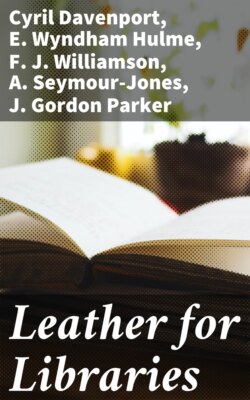Leather for Libraries

Реклама. ООО «ЛитРес», ИНН: 7719571260.
Оглавление
Cyril Davenport. Leather for Libraries
Leather for Libraries
Table of Contents
Chapter I. History of Sumach Tanning. in England, Degradation of the. Manufacture of Leather, and History. of the Reform Movement. BY. E. WYNDHAM HULME
Chapter II. The Causes of Decay in Bookbinding. Leathers. BY. J. GORDON PARKER
Chapter III. Provenance, Characteristics, and Values of Modern Bookbinding. Leathers. BY. A. SEYMOUR-JONES
Chapter IV. The Repairing and Binding of Books. for Public Libraries. BY. CYRIL DAVENPORT
Chapter V. Specification for the Fittings of a. Small Bindery. BY. F. J. WILLIAMSON
INDEX
ADVERTISEMENTS
INDEX TO ADVERTISEMENTS
Отрывок из книги
Cyril Davenport, E. Wyndham Hulme, F. J. Williamson, A. Seymour-Jones, J. Gordon Parker
Published by Good Press, 2021
.....
As might have been supposed, the rapid decay of leather bindings in the 19th century, resulting from a combination of the above malpractices, with the attendant evils of heavy outlay upon rebinding, cropped margins, and ill-matched sets upon the shelves, from time to time attracted the attention of booklovers and bookbinders; but their efforts to determine the causes of the deterioration and to find a remedy have until recently met with very little success. In 1842 the subject was investigated by Professors Faraday, Brande, and others on behalf of the Athenæum Club. This committee is largely responsible for the “sulphur in gas” theory—a theory which was never wholly true, even at a period when the percentage of sulphur in coal gas was much higher than at present (Cf. Journal of the Society of Arts, 1850-59, p. 215), and which now has ceased to have any practical bearing upon the matter. It should be noted that, in 1851, Crace Calvert, the well-known Manchester chemist, came to a different conclusion. After pointing out that decay in leather was observable in libraries, such as the Chetham Library, in which gas had never been used, he stated that the presence of sulphuric acid in leather bindings was attributable to one or more of three causes: (a) to the pollution of the atmosphere by consumption of coal in the Manchester factories; (b) to the action of gas fumes in unventilated rooms; (c) to the use of sulphuric acid by the tanners; and he further expressed his opinion that the seat of the disease would be found in irregularities in the processes of tanning—in other words, that the disease was aggravated rather than originated by these first two causes (Cf. Trans. Society of Arts, Vol. 51, pp. 120-22). Calvert’s views, however, met with very little support. In 1877, at the Conference of Librarians in London, a proposal was made that a committee of librarians and chemists should deal with the matter, but no effect was given to the proposal. Ten years later a series of experiments on the action of gas fumes and heat was undertaken on behalf of the Birmingham Library by Mr. C. T. Woodward (Library Chronicle, 1887, pp. 25-29). Strips of leather exposed for 1,000 hours to the action of gas fumes, at temperatures of 130° and 140° Fahrenheit, showed a mean absorption of sulphuric acid of 1·78 per cent., accompanied by a marked reduction in their stretching capacity and breaking strain. The experiments on the action of heat alone were regarded as inconclusive. Mr. Woodward suggested that the Library Association should undertake the testing of leathers, and that librarians should thereafter employ only leather of a given standard; but once more nothing was done. In the meantime the reputation of leather as a binding material continued to dwindle; one leather after another was tried, found wanting, and excluded from library practice, while various leather substitutes—buckram, art linen, and imitation leathers, gradually took its place. It is due to the efforts of Dr. Parker and Prof. Procter between 1898 and 1900 that the real facts of the case have been brought to light. In the latter years an agitation in favour of standard leather was set on foot by Lord Cobham, Mr. Cockerell, Mr. Davenport, and others, which resulted in the appointment by the Society of Arts of a Committee on Leathers for Bookbinding, the cost of which was met by a grant from the Leathersellers’ Company.
Upon the publication of the first report of the above Committee in 1901 the subject was taken up by the Council of the Library Association, and after several papers had been read at the monthly meetings in London and elsewhere, a Committee was appointed to ascertain how far Members of the Association were prepared to accept a common standard for binding leathers. For this purpose in March 1904, close upon 1,000 circulars were addressed to the libraries of the United Kingdom asking for a statement of their views upon the following proposals, amongst others, viz.: (a) that the Council should appoint an official analyst; (b) that they should publish a handbook giving to members of the Association such information as would enable them to secure sound leather at a reasonable price. The circular meeting with a favourable reception, the Council invited Dr. Parker to draw up a scale of fees for the analysis of leathers, and the scale having been duly approved, Dr. Parker was at once appointed analyst to the Association.
.....